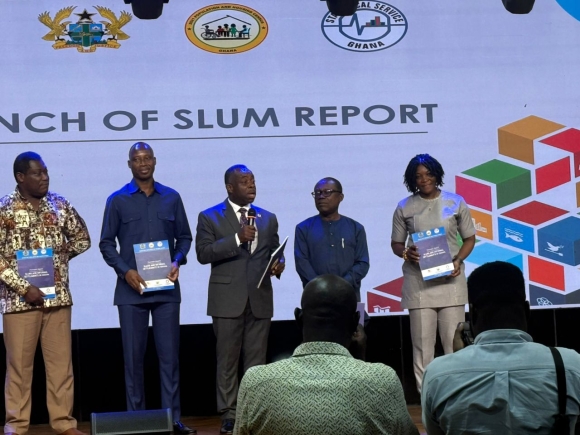More than 4.8 million Ghanaians, representing 30.8 per cent of the urban population, are living in slum conditions characterised by inadequate housing, poor sanitation, and limited access to basic services, according to a new report by the Ghana Statistical Service (GSS).
The findings, drawn from the 2021 Population and Housing Census, highlight severe disparities in living standards, with the Northern, Savannah, and Oti regions bearing the brunt of the crisis.
Launching the Slums and Informal Settlements Thematic Report in Accra on Monday, Government Statistician Dr. Alhassan Iddrisu described the data as a "mirror held up to our cities, our policies, and ultimately, our priorities."
He stressed that 46.1% of urban households—over 2.2 million families—face at least one form of deprivation, including lack of clean water, durable housing, or sufficient living space. "These are not abstract statistics. They are the daily realities of Ghanaians doing their best in circumstances they did not choose," he said.
The report defines slum households as those lacking improved drinking water, sanitation, durable housing, or living space (with three or more people sharing a room). Regional disparities are stark: the North East Region records the highest slum prevalence at 79.1 per cent, while the Northern, Savannah, and Oti regions show the most extreme conditions, with 4.2 per cent, 3.6 per cent, and 1.1 per cent of neighbourhoods, respectively, enduring all four deprivations.
Even in more developed regions like Greater Accra and Ashanti, over half of slum dwellers live in rented accommodations.
Dr. Evans Aggrey-Darko, Head of the Civil Service, warned that inaction would "risk locking another generation into poverty," urging coordinated interventions.
The data reveals alarming socio-economic gaps: non-literacy rates in slums (30.8 per cent) are double those in non-slum areas (14.0 per cent), while multidimensional poverty affects 23.4 per cent of slum residents compared to 10.5% elsewhere. Health outcomes are equally dire, with slum households reporting 42 deaths per 10,000 people—significantly higher than the non-slum average of 31.
Professor Stephen Owusu Kwankye, the report’s lead discussant, emphasised that slums are not confined to specific regions but are linked to systemic service gaps. The GSS has adopted a refined definition of urban areas—"Urban-2"—requiring localities to meet thresholds for population size, electricity, water, and access to schools and health facilities. Only 9.9% of Ghana’s 17,989 localities qualify.
Dr. Iddrisu called for targeted action, urging government agencies to prioritise slum upgrading in budgets and the private sector to invest in affordable housing and utilities. "Every slum we transform brings us closer to the inclusive, safe cities Ghanaians deserve," he said.

